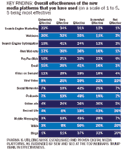Dive into Digital
Exclusive Pharm Exec survey details how pharma can make virtual channels effective marketing vehicles
Across industries, marketers are recognizing the power of digital marketing to establish real-time relationships with new and current customers while maintaining the ability to track and analyze customer touches and adjust accordingly. Looking at the digital landscape from a media-spend perspective, total Internet ad spend ($21.2 billion) in 2007 was up 26 percent from the year before, according to the Internet Advertising Board. A similar increase is expected for 2008.

David Johnson
But it's not just about Internet advertising. Smart marketers in B2C and B2B are utilizing a variety of digital channels—Web 2.0 tools such as blogs, wikis, social networks, and video—to engage with customers and create thriving relationships. What separates these marketers from others who may be experimenting with new media strategies? Channel integration.
Integration of these channels with traditional outlets such as TV, radio, direct mail, and direct sales, coupled with rigorous analysis, allows marketers to understand the consumption patterns of their content. This gives them the information to adjust their marketing mix, pushing spend toward channels that work, and pulling dollars from channels that don't work.

KEY FINDING: Manufacturers concerns in adopting digital marketing tactics; experience, ROI measurement top list
Going Digital
The pharmaceutical industry is facing formidable challenges. From influencing physicians to educating consumers to overseeing relationships with managed care organizations, pharma has unique market dynamics that make the go-to-market model far more complicated than a traditional push/pull paradigm. Interwoven with this complexity is the challenge of determining what actually drives prescription volume, and how to drive growth with increasingly tight budgets and new regulations amid high-risk product launches.
While other industries are beginning to take a multichannel marketing approach, pharma still prefers a "feet on the street" sales rep model. Top pharmaceutical companies are now experimenting with Web 2.0 strategies, but they have yet to put the pieces together to enable digital marketing outcomes to permeate their organizations.

KEY FINDING: Overall effectiveness of the new media platforms that you have used (on a scale of 1 to 5, 5 being most effective)
To find out just how far pharma marketers have come in implementing Web 2.0 strategies—and how far industry has to go—in 2008 MarketBridge and Pharmaceutical Executive magazine fielded "Digital Marketing in Pharma," a groundbreaking survey designed to shed light on the prevalence and effectiveness of digital marketing tools and techniques.
Details and Demographics
The following research was distributed primarily among Pharmaceutical Executive's subscribers and MarketBridge's Life Sciences Practice database. A total of 220 people completed the survey, answering questions on digital marketing and budgeting, usage of digital marketing channels, analytics, resources, and attitudes and beliefs.
Because of the respondents' wide range of job titles and responsibilities, the survey findings were segmented into four basic categories:
1. Executives: Presidents, CEOs, and other C-level titles that have authority over marketing and sales
2. Marketing: EVPs, vice presidents, directors, and managers of marketing organizations
3. Sales: EVPs, vice presidents, directors, and managers of sales organizations
4. Support: People who do not have direct authority over sales and marketing but may support one or both, including directors, managers of interactive, and operations
Key Findings
While the industry lacks the understanding, organization, and experience to measure digital marketing returns, it's slowly moving forward with implementation. Here's what the survey revealed:
Execs lack digital knowledge When asked to rate their understanding of digital marketing, nearly 45 percent of respondents said they "need to know more." Asked how prepared their companies are to plan and implement digital marketing strategies, only 12 percent said "well organized." More than a third said they were "not very well organized."
Measure ROI more easily with the right tools Respondents were equally concerned with their lack of experience with new digital marketing platforms and the inability to prove ROI with them—though many of the latest digital marketing tools and techniques actually make it easier to measure ROI. Close to 50 percent cited regulatory issues as a top concern.
Search engine marketing does the job Not surprisingly, pharma marketers cite search engine marketing, webinars, and organic search as their most effective digital vehicles. (See above.) Least effective: blogs and virtual networks. Interestingly, social networks, considered promising within the industry, were also on the low side of effectiveness.
The digital revolution has yet to hit While companies do use digital marketing channels, half of the respondents spend 10 percent or less of their budget on digital. The majority of pharma marketers (57 percent) are spending the most on what they are familiar with, mainly their own Web sites. Relatively few (10 percent) are spending toward Web 2.0 vehicles such as blogs, social networks, and video.
CEOs have most influence on strategies Digital marketing influence appears to come from the top down: next to business line/country managers, CEOs have the most influence on digital marketing strategies. Surprisingly, finance, which controls the purse strings, ranks below IT in influence.
Don't Wait, Integrate
Pharma's reluctance to deploy Web 2.0 tools is rooted in a lack of familiarity and a perceived inability to measure ROI. The fact that pharmaceutical marketers are not even experimenting with these tools will hamper efforts to fully integrate digital marketing within the organization. As it is now, they are missing opportunities to fully engage consumers and boost compliance.
There is a silver lining, however. Pharmaceutical marketers plan to fully integrate digital marketing in their strategies. Digital marketing spend is expected to rise, and digital has at least "some influence" in hiring, as organizations move more toward its adoption.
Bottom line: Pharma companies risk falling behind unless they recognize the need to utilize digital marketing platform tools to effectively reach their audiences.
For more information on the "Digital Marketing in Pharma" study, further interpretation of the results, and case studies pertaining to overcoming sales and marketing challenges, contact David Johnson, vice president, MarketBridge, at djohnson@market-bridge.com
The Misinformation Maze: Navigating Public Health in the Digital Age
March 11th 2025Jennifer Butler, chief commercial officer of Pleio, discusses misinformation's threat to public health, where patients are turning for trustworthy health information, the industry's pivot to peer-to-patient strategies to educate patients, and more.
Navigating Distrust: Pharma in the Age of Social Media
February 18th 2025Ian Baer, Founder and CEO of Sooth, discusses how the growing distrust in social media will impact industry marketing strategies and the relationships between pharmaceutical companies and the patients they aim to serve. He also explains dark social, how to combat misinformation, closing the trust gap, and more.
